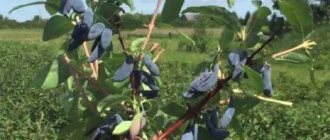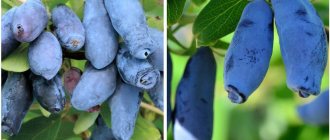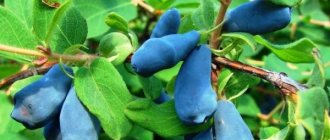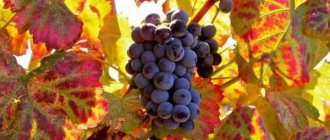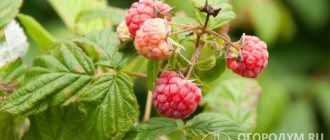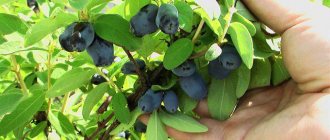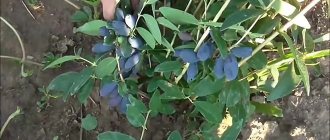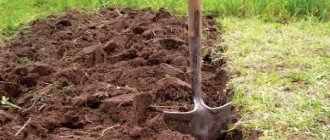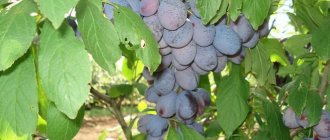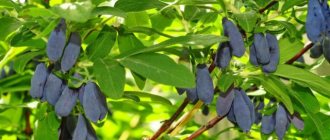Siberian is a variety of edible honeysuckle, characterized by high productivity and resistance to various adverse factors. We will learn how to create optimal conditions for the growth, development and good fruiting of shrubs.
Honeysuckle variety “Sibiryachka”
berries of the “Sibiryachka” variety are among the most delicious and sweet among edible honeysuckles
the fruits of honeysuckle “Sibiryachka” are well attached to the branches, so they can come off with damage
Main characteristics
The Sibiryachka variety is unpretentious and tolerates significant temperature fluctuations during the flowering period without consequences. Bushes can be used as a decorative component when arranging the local area and landscaping park areas.
| Characteristics/parameters | Description/meaning |
| Ripening time | Early, ripens in early – mid-June. |
| Productivity and fruiting | Fruiting is annual and begins 2-3 years after planting. In the first years, the yield is about 0.5 kg per bush, at the age of 8-13 years - 3.2-3.7 kg. Maximum at 14-15 years old – 4.5 kg (15 t/ha). |
| Frost/drought resistance | High frost resistance, withstands winter temperatures down to -50º C, flowers are not afraid of spring frosts down to minus 4-7º C. The variety is drought-resistant. |
| Regionality | All regions of Russia. |
| Resistance to diseases and pests | Rarely affected by pests, almost never gets sick. Fungal infections are possible with excessive watering. |
| Taste | The pulp of the berry is tender and juicy, sweet, aromatic, and pleasant to the taste (tasting score - 5 points). |
Pollinators
Although honeysuckle flowers are bisexual, the variety is self-sterile and requires cross-pollination. Good pollinators for Siberian are all simultaneously flowering varieties and hybrids of Altai, Kamchatka and Turchaninova honeysuckle. The best of them are recognized as: Tomichka, Pamyati Gidzyuk and Narymskaya.
The more different varieties of honeysuckle grow in one area, the more generous the harvest. When planting several plants of the same variety, the yield will be negligible, even if abundant flowering was observed.
Description of the variety
The Sibiryachka variety is not considered the newest, although it was registered only in 2000. This hybrid was obtained from Turchaninov and Kamchatskaya honeysuckles by the Bakchar Federal State Unitary Enterprise, located in the Tomsk region.
Specifications
A bush with an oval crown, medium height, moderately spreading - it reaches a height of 1.6 m and a width of 1.4 m. The shoots of Siberian honeysuckle are arched, the top hangs down. Mature branches are brown, with peeling bark.
The berries are drop-shaped, dark purple, with a whitish waxy coating. The weight of each varies between 1.0-1.4 g. The fruits of the Sibiryachka variety are among the most delicious and sweet among edible honeysuckles, their tasting score reaches 5 points.
The berries ripen early and quickly - only one harvest is needed. The average yield of honeysuckle variety Sibiryachka from an adult bush is 3.1 kg, under favorable conditions - up to 3.7 kg. The fruits are well attached to the branches and do not fall off when ripe, but they can come off with damage, so they are not suitable for freezing.
Comment! Siberian berries have very delicate pulp. This, on the one hand, makes them attractive for processing or fresh consumption, but on the other, creates difficulties during transportation and storage.
Pollinators
Edible honeysuckle is self-sterile, Siberian honeysuckle is no exception. To obtain a decent harvest, cross-pollination by bees or bumblebees with pollen of other varieties is necessary. Otherwise, the bushes will bloom, but will only produce a few small berries.
You can plant several other varieties next to Sibiryachka, but Tomichka, Pamyati Gidzyuk or Narymskaya are best suited as pollinators. There is no need to specifically attract bees and bumblebees to planting honeysuckle - it is a good honey plant and itself attracts beneficial insects to the garden.
Advantages and disadvantages
Siberian is an excellent variety for processing and fresh consumption. Among its advantages:
- Early maturation.
- Early fruitfulness of the variety. It is fashionable to try the first berries 1-2 years after planting honeysuckle.
- Good taste – tasting score 5 points.
- Stable fruiting.
- Large berries.
- High yield variety.
- Honeysuckle is extremely winter-hardy, it can withstand frosts of more than 50 degrees, the ovaries do not fall off at minus 7.
- The Sibiryachka variety does not fall off after ripening.
- You need to harvest the crop once.
- Durability and undemanding - with proper planting, honeysuckle bears fruit for 30 years.
Siberian has a significant drawback - its berries are so delicate that when harvesting it is not always possible to get a dry tear. This reduces transportability and makes the variety unsuitable for freezing.
Description of honeysuckle Sibiryachka
The variety is characterized by the following botanical characteristics:
- Bush. Slightly spreading, medium height, 1.4-1.7 m high. The crown is medium dense, hemispherical, 2.5-3 m in diameter. Leaves are medium sized, oval in shape. The flat, light green leaf blade has a blunt-pointed tip and a heart-shaped or rounded base. The leaf petiole is thin and short. The shoots are curved, slightly pubescent. The bark of young branches is green; as the bush matures, it acquires a reddish-brown color.
- inflorescences are reduced, two-flowered. The flowers are medium sized, pale yellow.
- The fruits are large, dark purple with a blue coating, elongated teardrop-shaped, spindle-shaped, slightly curved, 2.5-4.0 cm long, weighing 1.0-1.5 g. The peduncle is medium long.
The degree of fruit attachment is high, the detachment is dry. Siberian is a non-shattering variety. Slight shedding of berries may occur due to a lack of moisture during the ripening of the crop.
The video below provides an overview of the Sibiryachka honeysuckle:
Photo of bush and berries
The slow growth of bushes over 2-3 years is due to the biological characteristics of the plant. In the photo, the Sibiryachka variety looks like a bush 7-90 cm high, the crown diameter is more than 1 m. The shoots are brown, and the bark peels off over several years.
Young branches have slight pubescence, are slightly curved, and are located horizontally. The main feature of the Siberian species is the presence of a strip of anthocyanin color located on branches illuminated by sunlight.
Genetic characteristics of the variety:
- oval shape of the upper buds;
- axillary ocelli are located at an angle to the growing branches;
- the leaves are small in size;
- the tips of the leaf blades are pointed;
- their base is round in shape;
- small petioles;
- thin stipules are rounded, located at right angles to the shoots;
- the raceme consists of two flowers.
We recommend that you familiarize yourself with Golden gooseberry
At the beginning of spring, Siberian gooseberry is dotted with buds that bloom after 14 days. The flowers are pale yellow in color, the petals fit tightly to each other, the bracts have the shape of a sharp awl.
In June, fruits grow on the berry bush; their weight reaches 1.5 g. They have an elongated shape and a delicate aroma. Dark purple berries cannot be stored for a long time and transported over long distances.
Advantages and disadvantages
Advantages of Sibiryachka honeysuckle:
- stable annual fruiting;
- high productivity;
- resistance to severe frosts (up to -50º C) and spring frosts;
- large fruit;
- high taste, sweeter fruits than other varieties of honeysuckle;
- early maturation;
- resistance to diseases and pests, practically not affected by them;
- easily tolerates drought;
- the best option for the climate of the middle zone and northern regions.
Disadvantages of the variety:
- high probability of re-blooming in warm climates;
- the rather thin skin of the fruit eliminates the possibility of long-term transportation, during which the ripe berries will become crushed;
- curved shoots make harvesting a little difficult.
Description and advantages of the Sibiryachka variety
Honeysuckle variety Sibiryachka is a medium-sized shrub. Refers to early ripening varieties. Kept as a fruit-bearing and ornamental plant. Thanks to its beautiful crown, the shrub is used for landscaping areas, parks and squares. With its help, multi-tiered topiaries are created.
The crown is medium spreading, hemispherical, the foliage cover is of medium density. The height of the bush is more than 1.5 m. The shoots are slightly pubescent, curved, the lateral branches are directed to the sides. The diameter of the plant is 2-3 m.
The color of the branches is initially bright green, later turning into brown. The variety is characterized by an anthocyanin stripe on the south side.
The leaves are medium in size, oval in shape, and light green in color. Buds form in April or May and bloom in 7-10 days. Light yellow large flowers are collected in two-flowered inflorescences. Berries weighing 1-1.4 g appear in late May-early June.
The shape of the fruit is elongated, slightly curved. The berries are dark purple in color and covered with a light waxy coating. The aroma emanates pleasant, delicate. The pulp is sweet and sour and very juicy, easily separated from the stone.
The Siberian has many advantages:
- It is distinguished by colossal frost resistance.
- Withstands temperatures down to -40 C.
- Can be grown in northern latitudes.
- Tolerates sudden temperature changes during the flowering period.
The variety is high-yielding. A young bush produces 0.5 kg of fruit per season. An adult plant that has reached the age of 10 years will produce 3.5-3.7 kg of harvest.
Honeysuckle rarely suffers from diseases and pests.
Disadvantages include the thin skin of the fruit, which reduces shelf life and transportability. There is also a slight crumbling, especially in strong drafts.
Accommodation on site
With the right choice of seedlings and site for planting, honeysuckle will successfully develop and bear fruit in one place for 15-30 years.
Selection of planting material
A high-quality 2-3-year-old seedling should have 2-4 elastic and flexible shoots approximately 40 cm high. In the Sibiryachka variety they are curved. The root system of a healthy seedling is branched and has many small light-colored roots.
When purchasing, planting material is carefully inspected. The seedling should not have excessively elongated shoots, dry and long roots. Pay attention to the presence of buds on the shoots; if they are not there, the bush is unsuitable for planting.
If the bark on the shoots peels off, there is no need to worry. This is a biological feature of both seedlings and adult honeysuckle bushes. The peeled bark does not need to be removed from the branches.
Choosing a suitable location and conditions
Honeysuckle grows well and bears fruit in places protected from the wind and sunny. Lowlands flooded with melt water, with stagnant moisture and accumulation of cold air, are not suitable for planting. Shade and partial shade are also an unsuitable option. The fruits in such conditions will be small.
The crop is undemanding to soil, but grows poorly on light sandy and heavy clay soils. Honeysuckle prefers fertile loam, moisture-absorbing, with neutral acidity.
Step-by-step planting instructions
Honeysuckle is planted in the fall, at the end of September - the first half of October, and in the spring - as early as possible, before flowering. 2-3 year old seedlings are planted, the distance between them is at least 1.5 m.
Planting honeysuckle step by step:
- Dig holes measuring 60x60x50 cm.
- Add up to 10 kg of organic matter (compost, manure, humus), 40-50 g of potassium salt and superphosphate, 0.5 liters of ash to each. Mix the fertilizers well with the soil.
- Trim long roots to 30 cm.
- Dip them in earthen mash. To do this, first dig a hole in the space between the rows, fill it with water, and pour soil into it, then stir until the consistency of sour cream is obtained.
- Place the seedling in the hole on a pre-formed mound, spread the roots evenly and cover with soil. The root collar should be at ground level or slightly lower, no more than 3 cm.
- Compact the soil around the bush and water thoroughly.
- Mulch with a layer of 1-2 cm using humus, peat or loose soil.
Planting and care
The most favorable time for planting is from late August to mid-September, since honeysuckle is highly resistant to low temperatures.
To place berry bushes, you must choose a well-lit, sunny area. The plant is grown using cuttings and seeds.
Before purchasing young seedlings, it is necessary to inspect the honeysuckle and not purchase bushes that have dry branches or long roots. The bark on the shoots should not have any defects, such as peeling areas. The Siberian will die after replanting if there are dark spots on the rhizome and branches, indicating fungal damage.
We recommend that you read: Soil for gooseberries
On loamy soil, honeysuckle bears fruit abundantly; in partial shade the plant will not dry out, but the harvest will be small. Dry lands and low depressions in which water stagnates are unsuitable for planting.
Strong winds have a negative effect on the formation of flowers and ovaries. Honeysuckle is demanding on soil composition, oxygen supply, and loves fertile lands. Bushes should not be planted on clay soils; in this case, pale green leaves and short annual growth will appear on the branches.
Before planting, organic fertilizers are added to poor soil (5 kg per 1 m²). To obtain a large harvest, gardeners use several shrubs of different varieties. The distance between them should not exceed 2 m. In the first 4 years, the bushes grow slowly; the period of abundant fruiting for honeysuckle begins 6-8 years after planting.
The Sibiryachka variety is undemanding to care. The plant loves moisture; the bushes need to be watered often in hot weather. The crown should be sprayed with warm, settled liquid. This procedure is carried out before laying the eyes. In early spring, the gardener applies nitrogen fertilizers to the bush.
In late autumn, the plant needs fertilizing containing potassium and phosphorus. The slow growth of honeysuckle in the first 4 years requires constant loosening of the top layer of soil after abundant watering. The space next to the roots is mulched with humus or peat.
Adult honeysuckle bushes are characterized by peeling of the bark as a result of aging and death of shoots. The plant needs to remove dry branches in the fall (after leaf fall) or early spring.
Berry bushes older than 7 years require sanitary pruning. Broken, dry shoots are removed from the plant. First of all, the branches of the lower tier are cut off, because shoots lie on the surface of the soil, interfere with care, and do not bear fruit. In adult bushes, the crown is thinned out every 3 years, leaving only 5 powerful branches.
The tips of the shoots of honeysuckle should not be removed, since they contain a large number of flower buds. Old bushes are pruned at a height of 0.3-0.4 m from the ground surface. The plant will begin to recover in the spring, and the first shoots will grow on the stumps.
We recommend that you read Interesting facts about raspberries
Growing honeysuckle
The Siberian quickly takes root in the designated place, and all the plant needs in the future is proper care.
Caring for a young plant
The first one or two years, honeysuckle grows slowly. This time is spent on the formation of a developed root system of the plant. All care for young plantings comes down to timely removal of weeds, watering as the soil dries out and loosening to a depth of no more than 5-8 cm.
We recommend reading the article on how to care for honeysuckle in the autumn.
Caring for an adult plant
Subsequent care for Sibiryachka honeysuckle is the same, but activities such as fertilizing and pruning are added.
Feeding. It is recommended to do it from 3-4 years after planting, when the bush produces at least 0.5 kg of berries. Organic fertilizers are applied by mulching. Early in spring or late in autumn (once every 1-2 years), 0.5-1 bucket of peat-humus mixture or compost with the addition of 0.5-1 liters of wood ash is scattered under each bush.
Read the article about when and how to fertilize honeysuckle in each season of the year.
Fertilizing with mineral fertilizers is combined with good watering, and is carried out according to the following scheme:
| Top dressing | Compound | Target |
| First (during the period of mass bud burst) | 25 g of ammonium nitrate per 1 sq. m | increased shoot growth |
| Second (after flowering) | 10 g of ammonium nitrate + potassium salt and double superphosphate - 15 g per square meter. m | ripening of shoots, their preparation for wintering |
| Third (in autumn, with embedding in the soil to a depth of 5-8 cm) | potassium salt – 15 g, double superphosphate – 15 g | growth and development of the root system, increasing the frost resistance of the bush |
Watering. Honeysuckle does not tolerate waterlogged soil, but loves moderate watering, especially in the hot season. 3 buckets of water are poured under an adult plant, evenly distributed around the trunk circle.
It is especially important to saturate the soil with moisture during the flowering period and at the beginning of the mass ripening of berries. In the absence of watering at this time, the plant loses up to 50% of the harvest.
Trimming
Honeysuckle is prone to thickening of the crown; it is pruned according to the following rules:
- For the first 6-10 years, the plant only requires sanitary pruning. Remove broken, frozen, dried and weak branches, as well as branches growing down or inside the bush.
- After several years of fruiting, heavily thickened bushes are thinned out, cutting out some of the old skeletal branches (more than 8-10 years old) at the base. If you leave a stump of 7-8 cm, then next year replacement shoots will appear from it. This pruning is carried out every 2-3 years.
For an adult fruiting bush, the optimal presence is no more than 15 skeletal branches of different ages. The most powerful shoots are left, the rest are removed.
- By about 20-25 years of age, the fruiting of honeysuckle dries up. They practice rejuvenating pruning of old bushes. In the fall, all skeletal branches are cut off, leaving stumps 15-20 cm high, on which young strong shoots will grow in the spring of next year. After a year, the plant is restored, and the fruiting period is extended for another 5-10 years.
Wintering
Due to its high frost resistance, the Siberian does not need to bend down the branches and cover with snow during periods of severe cold.
Agricultural technology
Agrotechnical measures necessary for the variety come down to the correct choice of planting site, organization of the planting and care procedure itself, which consists of watering, fertilizing, pest control, as well as pruning and shaping the bush.
Selecting a location
Due to the fact that the crop will occupy the planting space for many years, it is worth choosing it carefully, taking into account such features as lightening and pH level.
If you do not want to have problems in the process of growing “Sibiryachka” and want to get a stable harvest, then select well-lit places for the plant, protected from drafts and sharp gusts of wind. Due to lack of light, the shoots of the bush will begin to stretch in length, and the buds will form more slowly. Wind and drafts can cause flowers and ovaries to fall off, and, accordingly, the loss of the crop.
The Sibiryachka soil prefers loamy and moderately moist soil. Swampy and acidic soils have a negative impact on plant productivity - they reduce performance.
Planting and care
The optimal time for planting “Sibiryachka” is autumn, about two to three weeks before the onset of frost (mid-September-October). You can plant the crop in the spring (the first ten days of April), but then the seedlings will not take root well.
Important! It is strictly forbidden to trim the shoots of seedlings before planting or immediately after it. This procedure will lead to poor plant survival and late fruiting.
The landing procedure includes the following mandatory steps:
- Preparation of planting holes with parameters 40x40x40. To each dug hole you need to add organic matter (humus, compost, peat) - 1 bucket and phosphate-potassium fertilizers (50 g each). The distance between holes should be 1.5 m, and between rows - 2 m.
- Immediately before planting, you need to pour a bucket of water into the hole and wait until it is absorbed by the soil.
- In the center of the hole it is necessary to form a mound of fertile soil and plant a seedling on it. When placing the seedling in the hole, carefully straighten the root system.
- The hole must be filled in and the soil must be compacted well around the trunk of the seedling.
- Immediately after planting, the plant is watered again and the soil around it is mulched, using humus or peat as mulch.
"Siberian" does not tolerate drought, so it should be watered regularly. Without water, the plant will look depressed and you should not expect a good harvest or high decorative qualities from it. As soon as the earthen ball under the crop dries 20–30 cm, you need to add a bucket of water. The bush prefers not only watering, but also spraying of foliage and shoots. A day after watering, it is necessary to loosen the soil near the bush so that oxygen reaches the roots.
Mandatory care measures for honeysuckle include fertilizer. “Sibiryachka” receives the first portion of fertilizers during planting. This is enough for her to live for 2 years. After 2 years, you need to start stable fertilization: in the spring - with nitrogen (1 tablespoon of urea per 1 bucket of water for 1 bush), in the summer - with vitamin and mineral fertilizers (a bucket of organic fertilizers per bush), in the fall - with phosphorus and potassium (1 l wood ash for 1 bush).
Features of pollination
“Siberian” flowers are sterile, so in order to get a crop harvest, you need to plant pollinators on the site that belong to the Honeysuckle family. As pollinators, you can choose any Altai, Siberian or Kamchatka variety, for example, “Volshebnitsa”, “Tomichka”, “Kamchadalka”.
Did you know? There is a popular belief that edible honeysuckle berries can be distinguished from inedible ones by their color: you can only eat black and blue fruits, but not orange and red ones.
It will be enough to plant 2-3 pollinating plants on the site. Honeysuckle flowers emit a pleasant and sweet aroma, which quickly attracts bees and other insects, so pollination takes place quickly and efficiently.
Disease and pest control
Despite all the efforts of breeders, developing a variety that is absolutely resistant to diseases and pests is almost impossible. Like other honeysuckle varieties, “Sibiryachka” is susceptible to the negative influence of ailments.
Important! Since “Sibiryachka” belongs to edible varieties, spraying with chemicals can be carried out only after harvesting.
Among the most common are:
- honeysuckle aphid . The presence of a small light yellow insect is signaled by the curled leaves of the plant, which rapidly turn yellow or become covered with spots. The pest can cause growth retardation and even death. Effective means of combating honeysuckle aphids are solutions of “Aktellika”, “Confidor”, “Rogora”, “Aktara”. For preventive purposes, bushes are sprayed with tobacco, garlic or pepper infusion at the beginning of summer;
- honeysuckle mite , which announces its presence by brown, shapeless spots on the foliage, and the appearance of sooty fungi on the surface of the leaf plate. Damaged leaves begin to fall off prematurely. You can eliminate the uninvited guest by spraying the honeysuckle with a solution of “Aktellika”, “Rotor”, “Mavrika”. Preventive measures that should be carried out constantly include weeding the soil under the crop, thinning thickened bushes, since wet, shaded and thickened conditions are a favorable environment for the appearance of the pest;
- The honeysuckle fingerwing is a small caterpillar that feasts on the pulp and seeds of honeysuckle fruits. The pest can destroy the crop: the berries do not ripen, darken and crumble. An effective means of combating the caterpillar is the drug "Inta-Vir", the solution of which is prepared in strict accordance with the dosages specified in the instructions. For preventative purposes, you can spray the bushes with an infusion of potato or tomato tops;
- fungal diseases: ramularia - brown spot on foliage, cercospora - brown spot, powdery mildew - white spot. Spraying with a solution of “Topaz” and “Fundazol” will help overcome fungal diseases. Prevention consists of timely loosening the soil under the bushes and thinning the plants.
Pruning and crown formation
The essence of annual pruning and shaping of the bush comes down to removing dried and broken shoots, dried inflorescences and prematurely darkened leaves. Starting from the age of 15, you need to cut out old skeletal branches at soil level.
Find out how to properly transplant honeysuckle to a new location.
This is called anti-aging pruning. When your honeysuckle turns 20 years old and you begin to notice a rapid decline in yield, it is necessary to cut off the bush completely, leaving stumps 15–20 cm high.
It will take one season for the bush to grow and it will bear fruit for another 5–10 years. The formation of a bush consists of thinning it. After all, dense honeysuckle bushes are a direct path to plant diseases and pests.
Wintering
Since “Sibiryachka” is a frost-resistant variety, bred specifically for Siberian conditions, there is no need to take special measures to prepare for winter. There is no need to cover the bush; you just need to mulch the soil with peat or humus before the onset of frost.
Important! In gardening, there are known facts of honeysuckle re-blooming in early autumn, subject to prolonged, consistently warm weather. You should not be happy about this phenomenon, since you will not only not get a second harvest, but you will also not be able to pick tasty berries for the next season. Therefore, as soon as you see autumn buds, pick them off immediately.
Reproduction methods
Honeysuckle is propagated in several ways:
- By layering. Young (one-year-old) branches of the plant, inclined to the ground, are used. In early spring, the shoots are bent, pinned, and sprinkled with nutritious soil, after which they are watered. By autumn, the cuttings will produce roots. Plants are separated and planted.
- Seeds. This is a rather labor-intensive and lengthy process with an unpredictable result, since seed propagation does not guarantee that the varietal qualities of the plant will be preserved.
- Dividing the bush. In autumn or early spring, 3-5 year old bushes are dug up, divided according to the number of skeletal branches that have their own rhizome, and then planted.
- Green cuttings. The best time is mid-June - early July. Select strong shoots of the current year, capturing old wood (cut off with a “heel”). They are kept in a solution of a root formation stimulator, after which they are planted in a loose, moist soil mixture (compost, peat, sand). Cover with film and spunbond on top for shading.
Harvesting, what are the benefits of berries
The main crop ripens in 7-10 days. Collection is carried out in one go. Berries of the Sibiryachka variety do not last long when fresh. Transportability of fruits is low. Therefore, gardeners prefer to make blanks from honeysuckle.
The berries are used to make compotes, preserves, juice, and jam. They are frozen and pureed.
The fruits contain healthy vitamins and minerals:
- vitamin C
- folic acid
- organic acids
- iron
- zinc
- magnesium
Recommended use for the prevention of atherosclerosis and vitamin deficiency. Increases the body's defenses and resistance to viruses and bacteria. Berries are useful for respiratory and intestinal infections.
An excellent solution to plant Sibiryachka Honeysuckle in your home; the description of the variety speaks of its stability and ease of care. The plant feels great in different climatic zones. The shrub is excellent for landscaping areas. The fruits are consumed raw and stored for the winter.
You will learn more about growing honeysuckle by watching the video:
Problems during cultivation
Honeysuckle has no predisposition to diseases; in rare cases, it can be affected by powdery mildew in cold and damp summer conditions. The crop is treated for a fungal disease using an appropriate fungicide; for example, the biological product Fitosporin is used.
In addition, there is a possibility of honeysuckle re-blooming in a warm, long autumn (late October - early November). The plant may bloom a second time if, after a short drop in temperature below 0º C, prolonged warming occurs.
The cause of the second wave of flowering may be a thaw in winter, which is not uncommon in the European part of the Russian Federation. In such conditions, the apical buds bloom and honeysuckle blooms. Subsequent cooling leads to the death of the blossoming buds, which significantly reduces the yield.
It is recommended to remove the buds immediately after detection. To reduce damage, all damaged branches of affected honeysuckle bushes are cut off in early spring, which promotes the growth of new shoots. And to increase their growth activity during flowering, they are fed twice (with an interval of 10-12 days) with nitrogen fertilizers.
Honeysuckle 2021
Moderators: Vital, Roman S.
- Go to page:
Messages: 371 Registered: 10/19/2016, 03:31 Interests: honeysuckle, blackberry From: Bavaria, Augsburg Thanked: 825 times Thanked: 414 times
Status: Offline
Honeysuckle 2018
Posted by Bavarian » 01/02/2018, 01:10
Discussion of other seasons:
Honeysuckle 2006-2014 – viewtopic.php?f=28&t=3196 Honeysuckle 2015-2016 – viewtopic.php?f=28&t=7564 Honeysuckle 2017 Honeysuckle 2019 – viewtopic.php?f=28&t =7561
Messages: 2671 Registered: 09/25/2009, 01:49 From: Moscow, dacha north Moscow Region Thanked: 2291 times Thanked: 1163 times
Status: Offline
Honeysuckle: expert advice
Message from KryzIr » 01/02/2018, 02:02
Messages: 491 Registered: 08/20/2016, 14:58 From: Moscow. dacha in Balabanovo Kaluzh. region Thanked: 241 times Thanked: 335 times
Status: Offline
Honeysuckle: expert advice
Message from Pavel summer resident » 01/02/2018, 15:17
Messages: 3839 Registered: 04/12/2010, 09:43 From: Far beyond S. Posad, Lefortovo Thanked: 1134 times Thanked: 2560 times
Status: Offline
Honeysuckle: expert advice
Message from Nyur » 01/02/2018, 15:28
Messages: 581 Registered: 01/07/2017, 13:53 From: Mikhailov, Ryazan region. Thanked: 509 times Thanked: 537 times
Status: Offline
Honeysuckle: expert advice
Message from Peter » 01/02/2018, 16:00
Messages: 371 Registered: 10/19/2016, 03:31 Interests: honeysuckle, blackberry From: Bavaria, Augsburg Thanked: 825 times Thanked: 414 times
Status: Offline
Honeysuckle: expert advice
Posted by Bavarian » 01/02/2018, 16:52
Messages: 879 Registered: 10/22/2012, 04:35 pm Interests: gardening, forest, fishing Occupation: Orthodox theology and religious studies, medicine From: Moscow and Taldomsky district of Moscow Region Thanked: 468 times Thanked: 574 times
Status: Offline
Honeysuckle: expert advice
Message from Hare » 01/03/2018, 07:56
Messages: 491 Registered: 08/20/2016, 14:58 From: Moscow. dacha in Balabanovo Kaluzh. region Thanked: 241 times Thanked: 335 times
Status: Offline
Honeysuckle: expert advice
Message from Pavel summer resident » 01/03/2018, 11:40
Messages: 530 Registered: 12/20/2014, 00:27 Occupation: pensioner From: Dacha South, Taldom district, Moscow region. Thanked: 201 times Thanked: 623 times
Status: Offline
Honeysuckle: expert advice
Posted by bodge » 01/03/2018, 13:01
Messages: 581 Registered: 01/07/2017, 13:53 From: Mikhailov, Ryazan region. Thanked: 509 times Thanked: 537 times
Status: Offline
Honeysuckle: expert advice
Message from Peter » 01/03/2018, 13:42
Messages: 67 Registered: 09/11/2011, 18:03 Occupation: pensioner From: Istra, Moscow region Thanked: 124 times Thanked: 53 times
Status: Offline
Honeysuckle: expert advice
Posted by Valentin » 01/03/2018, 14:23
Messages: 530 Registered: 12/20/2014, 00:27 Occupation: pensioner From: Dacha South, Taldom district, Moscow region. Thanked: 201 times Thanked: 623 times
Status: Offline
Honeysuckle: expert advice
Posted by bodge » 01/03/2018, 14:57
Messages: 371 Registered: 10/19/2016, 03:31 Interests: honeysuckle, blackberry From: Bavaria, Augsburg Thanked: 825 times Thanked: 414 times
Status: Offline
Honeysuckle: expert advice
Posted by Bavarian » 01/04/2018, 02:39
Messages: 265 Registered: 10/20/2015, 03:59 From: Khabarovsk Thanked: 112 times Thanked: 123 times
Status: Offline
Honeysuckle: expert advice
Message from Vlad dv » 01/04/2018, 16:54
Messages: 581 Registered: 01/07/2017, 13:53 From: Mikhailov, Ryazan region. Thanked: 509 times Thanked: 537 times
Status: Offline
Reviews of the Sibiryachka honeysuckle variety
★★★★★
Anna Grigorievna, 46 years old, summer resident, Crimea. In addition to Sibiryachka, I have planted 5 more Bakchar varieties of honeysuckle on my plot.
I grow it in partial shade. There is little watering, but they can withstand the heat. Closer to August, some of the leaves turn brown and fall off, but still in the spring the bushes bloom and bear fruit. I wanted to check, I doubted that they would withstand our climate, but here they are! ★★★★★
Sergey, 44 years old, driver, Khabarovsk region. I have been growing honeysuckle in my dacha for more than 8 years.
I planted Sibiryachka bushes in the fall of 2011 on the sunny side, they grew well and are unpretentious. The largest berries are about 3.5 cm, elongated, the taste is sweeter than that of the Blue Bird and Silginka. Hide
Add your review
Siberian will grow and bear fruit in any region, but it is worth considering that the natural conditions for this crop are frosty winters and short summers. In warm climates, Sibiryaka can bloom again in the fall.
0
0
Copy link
Honeysuckle - edible varieties of wolfberry
Honeysuckle
Honeysuckle is a plant that is common in the northern hemisphere of our planet. Modern science knows almost 190 of its varieties, some of which are poisonous, while others are palatable and healthy. There are 14 varieties of culture in Russia. It is quite unpretentious and therefore is especially popular among both novice gardeners and professionals. Beautiful flowers delight the eye during flowering, and the berries pleasantly surprise with their taste.
Honeysuckle is popularly called “wolfberry” or “shameless.” Bushes of wild plants can be found quite often in central Russia. It is worth remembering that their berries are not edible. Summer residents plant wolfberry as an ornamental flowering plant, and for its fruits. There are climbing varieties that will perfectly decorate gazebos and recreation areas. And from those that bear fruit well, 3 kg of healthy berries are usually collected, which are then eaten both raw and processed.
Fruit varieties of the plant ripen earlier than other berries and fruits. While strawberries are blooming and setting in your garden or garden plot, and the first green cherries are appearing on the trees, you can enjoy the taste of unpretentious honeysuckle.
The most popular edible plant varieties are:
- Amphora;
- Berel;
- Enchantress;
- Gourmand;
- Leningrad giant;
- Moraine;
- Pavlovskaya;
- Siberian;
- Titmouse;
- Blue bird.
When choosing honeysuckle as a shrub that will bloom and bear fruit in the country, you must remember that absolutely all varieties of this plant bear fruit only in the third year after planting. The berries have a sweet and sour taste and are quite large in size. All young honeysuckle bushes have fluffy leaves that lose their edge over time. The height of the plant, the fruits of which are edible, rarely reaches 3 meters, which is also very convenient for harvesting.
In order to obtain a bountiful harvest, it is recommended to plant honeysuckle in groups consisting of several varieties. The plant is cross-pollinated, and, therefore, green neighbors of the same species are vital for it.
This variety is considered one of the best for eating and preparing food for the winter. It was brought out relatively recently, 20 years ago, by specialists from the Northern capital of Russia. And its predecessor is Kamchatka honeysuckle. Speaking about the characteristics of Amphora, it is worth noting that it has quite large fruits, which can reach a length of 2-3 cm. Externally, the berries are shaped like ancient Greek amphoras, which is why the variety got its name. It bears fruit for 20 years, which is also a definite plus for a gardener.
Amphora fruits have a fairly dense skin, which allows them to be transported to the right place without any problems. The first berries appear on this variety in early June, and the honeysuckle itself bears fruit until the end of the month. It is recommended to plant it together with the Sorceress or Morena. In a good year, you can collect up to 2 kg of dark blue berries from a bush.
The description of Amphora is quite common: the plant is a green bush up to 1.5 meters high. The dark green foliage of honeysuckle forms a semicircular crown, the branches are distinguished by a reddish-brown color. The fruits sit firmly on the branches and rarely fall off. Amphora is also resistant to winter temperatures and tolerates frost normally.
The Berel variety can also be found quite often in the personal plots of honeysuckle lovers. The height of the bush reaches 1.6 meters, the branches and light green leaves form a semicircular crown. Berel berries are 2–2.5 cm long, shaped like small pears and have a slightly tart, sweet and sour taste. The skin of the fruit is quite thin, and therefore they must be transported very carefully or processed close to the place of collection.
The plant is characterized by high early maturity, as it begins to bear fruit already in the second year after planting. To get a good harvest of oval berries (with proper care, Berel can produce up to 2 kg), the variety must be planted next to the Blue Spindle or Kamchadalka honeysuckle.
Honeysuckle Sorceress is a low bush that rarely reaches a height of 1.6 meters. The leaves of the plant do not have the usual hairy edge for honeysuckle, and the berries are medium in size, 2 cm. The shape of the fruits is ellipsoidal, and they taste sweet with a barely noticeable sourness without viscosity or bitterness.
The first berries begin to ripen on the Sorceress in mid-June. In order for honeysuckle of this variety to bear fruit well, it is recommended to plant it with Long-fruited, Izyuminka and Sineglazka. The fruits of the Sorceress can easily withstand transportation, and the plant itself is resistant to frost, disease and drought.
This is a variety that grows quite slowly. The plant reaches a height of 1.4 meters only by the age of ten, and at the age of 3-4 years it rises above the ground at a distance of 70-80 cm. The bushes of this species are quite densely covered with light green foliage, and the berries are shaped like an oval. The average size of Gourmet fruits is 2-3 cm in length. They taste sweet and sour and are perfect for those who love a pronounced sourness.
The skin of Lakomka berries is quite dense and therefore the crop can be safely transported without worrying about it losing its presentation or simply releasing juice and “flowing.” They eat both raw fruits and preserves and jams made from them. In order for this variety of honeysuckle to produce a high yield, it is recommended to plant it next to Nymph, Morena and Bluebird. You can collect up to 3 kg of berries. And from a plant 6-7 years old, summer residents collect 3.5 - 5.5 kg. They ripen at the end of June, starting from the 16th of the calendar month.
From the name of the variety it is clear that the berries of this plant are quite large, and the honeysuckle itself was bred in St. Petersburg. Breeders from the Pavlovsk Scientific Institute of Russia worked on it. The bush is tall, often reaching a height of 1.6-2.5 meters. Gardeners love it for its unpretentiousness, early ripening and high yield. The first fruits from the Leningrad giant can be collected when the crop reaches the age of 2-3 years.
The berries are quite long, usually reaching 2.2-3.3 cm. The fruits have a pleasant taste, sweet and sour, without bitterness or viscosity. In order for the bushes to bear fruit well, they must be planted with Malvina, Morena and Bluebird. This variety of honeysuckle is distinguished by a long period of fruiting; the berries ripen on the Leningrad giant from mid-June to mid-July. The variety is not afraid of transportation and does not lose its presentation even after being in boxes for a long time.
Another view obtained by Pavlovsk specialists from the Northern capital. The plant is an early-ripening variety, and the first berries appear on it in mid-June and delight summer residents until the beginning of July. The height of an adult crop reaches 1.6-1.7 meters and is quite often used as a decorative plant because it blooms beautifully and looks aesthetically pleasing.
Morena berries are shaped like the tail of a fairy-tale mermaid, which is why it is also called the Little Mermaid. Externally, the fruits are dark blue, shiny and lumpy. They usually reach 2.4-3 cm in length. They taste pleasantly sour with a pronounced sweetness. The variety is characterized by high yield - up to 2.3-2.5 kg of berries per bush. It is recommended to plant moraine in a permanent place with such green neighbors as Amphora, Kamchadalka and Blue Bird.
The Pavlovsk variety is also loved by summer residents and gardeners. The bush usually reaches 1.4 meters in height and is itself a short representative of this species. It bears fruit with small berries, which usually grow no more than 2 cm in length. Pavlovsk honeysuckle is characterized by low shedding and tolerates transportation well to its destination. The taste is standard, sweet and sour, without bitterness, which is inherent in wild species of the plant.
The Sibiryachka honeysuckle variety is perfect for growing in the harsh climate of the north. It tolerates sudden temperature changes well even during flowering. The height of an adult bush usually reaches 1.6 meters. Siberian fruit bears large purple berries, the length of which is 2-2.6 cm. The shape of the sweet fruits resembles a spindle. The bush bears fruit already in the second year after planting and up to 2 kg of harvest can be harvested from one plant, and a 14-year-old plant brings its owner up to 5 kg. Desirable neighbors for Sibiryachka are Narymskaya and Tomichka honeysuckles.
Titmouse belongs to the early ripening varieties. An adult plant can reach 2 meters in height, and begins to bear fruit in the second year after planting. The berries have a characteristic blue color, which is why the variety got its name. The taste of the fruit is more sweet than sour, 3 cm long. The plant bears fruit abundantly for 30 years. The fruits do not tolerate transportation well and are stored in the refrigerator for no more than 3 days. Experts recommend planting Titmouse near Malvina or Kamchadalka.
The bluebird is also one of the rather tall representatives of honeysuckle. A mature plant often reaches a height of 1.8 meters. The fruits on the bushes of this variety appear in June, are 2 cm long and resemble barrels in shape. Bluebird has a fairly thin skin, which does not contribute to the integrity of the fruit during transportation. Weight up to 3 kg, but for this he must be at least 6 years old. The best pollinators for Bluebirds are Morena and Titmouse.
In order for honeysuckle to begin to bear fruit earlier, experts recommend planting the plant in the fall, when nature falls asleep. This is due to the fact that its bushes begin to drive sap along the branches quite early and in the spring the crop already wakes up. The selected bushes are planted in a well-lit place where there are no drafts.
Before the roots of honeysuckle touch the soil, it is recommended to fertilize the soil in this place. To do this, dry grass, compost and potassium salt are added to the pit. For planting, a hole 40 cm deep and 50 cm wide is dug and a mound is placed in the center. The seedling is placed on an embankment, its roots are carefully straightened, then covered with earth and watered. You can also mulch the soil with peat.
Honeysuckle does not require any special care. It is enough to water it and remove dried branches from the bush. Varieties that do not tolerate frost well are covered for the winter. In order to grow a plant that will please the eye and bear fruit, you need to choose the right variety and carefully read its description on the annotation.
vusadebke.com
Features of cultivation
When choosing seedlings in a nursery or flower shop, they should be carefully inspected. Young plants should not have excessively elongated branches and long or dry roots. The shoots of high-quality seedlings bend easily and do not break; their bark does not peel off. It is better to refuse the purchase if dark spots are found on the branches or roots, which often indicate that the honeysuckle is damaged by a fungal infection.
Recommendation: Siberian honeysuckle propagates by seed, but in this case you will have to wait several years for the first harvest. Therefore, gardeners prefer cuttings, which allow them to preserve all the varietal characteristics of the mother specimen.
Site selection and planting
Honeysuckle variety Sibiryachka easily tolerates frosts down to 40°C. The shrub blooms and bears fruit well when planted on loamy soils, which contain many nutrients. The yield of berries is significantly reduced when grown in soil with acidic pH values, so lime is added to the hole before planting the cuttings. For planting honeysuckle you should choose the following areas:
- illuminated by sunlight most of the day;
- not blown by strong winds.
In shrubs planted in shade or partial shade, shoots quickly lengthen, and flower buds are formed in insufficient quantities.
Warning: If Siberian honeysuckle is grown in windy areas, then a gust of strong wind can tear off all the ripe berries or just bloomed flowers from the bush.
Quality care
Siberian honeysuckle tolerates lack of watering well, but only for a short period of time. Experienced gardeners recommend adding water to the root after the earthen ball has dried out 20-30 cm deep. The shrub also likes frequent spraying of leaves and shoots. After such a water procedure, they are moisturized, and flower buds are formed abundantly. High-quality honeysuckle care also includes the following activities:
- timely removal of dry inflorescences, twigs, darkened leaves;
- regular weeding and loosening;
- pruning elongated shoots.
The flowers of the shrub are sterile, so it is necessary to plant 2-3 specimens of plants of the Honeysuckle family in the garden plot. Good pollinators of Sibiryachka honeysuckle are all Altai, Siberian, Kamchatka varieties - Volshebnitsa, Tomichka, Kamchadalka.
Sources:
https://ogorodsadovod.com/entry/3513-zhimolost-sibiryachka-osobennosti-sorta-posadka-i-pravila-ukhoda https://sortoved.ru/zhimolost/sort-zhimolosti-sibiryachka.html https://mirogorodov. ru/zhimolost-sibiryachka.html
Planting honeysuckle: choosing seedlings and location
Siberian honeysuckle propagates using seeds and cuttings. For amateur gardeners, the second method is preferable. Seed germination and rooting will take too long.
If you want a healthy plant, carefully inspect the seedlings before purchasing.
Please note the following:
- Absence of defects such as elongated branches, dry or excessively long roots.
- The shoots of a healthy seedling are elastic and do not break from slight bending.
- The bark should be smooth, without flaking particles.
- Do not purchase a plant with dark spots on the rhizomes or branches. This indicates a fungal infection.
Choose your planting site carefully, as honeysuckle will grow in one area for 20-40 years. Give preference to loamy soil, on which the tree produces rich harvests. In an acidic environment, fruiting is significantly reduced.
The area should be well lit and protected from sharp drafts. In shaded areas, branches quickly stretch out and buds form weakly.
Planting of seedlings is carried out in the fall. As an exception, honeysuckle is planted in the spring. This should be done no later than the first ten days of April, before flowering begins. Specimens planted in spring take root less well.

